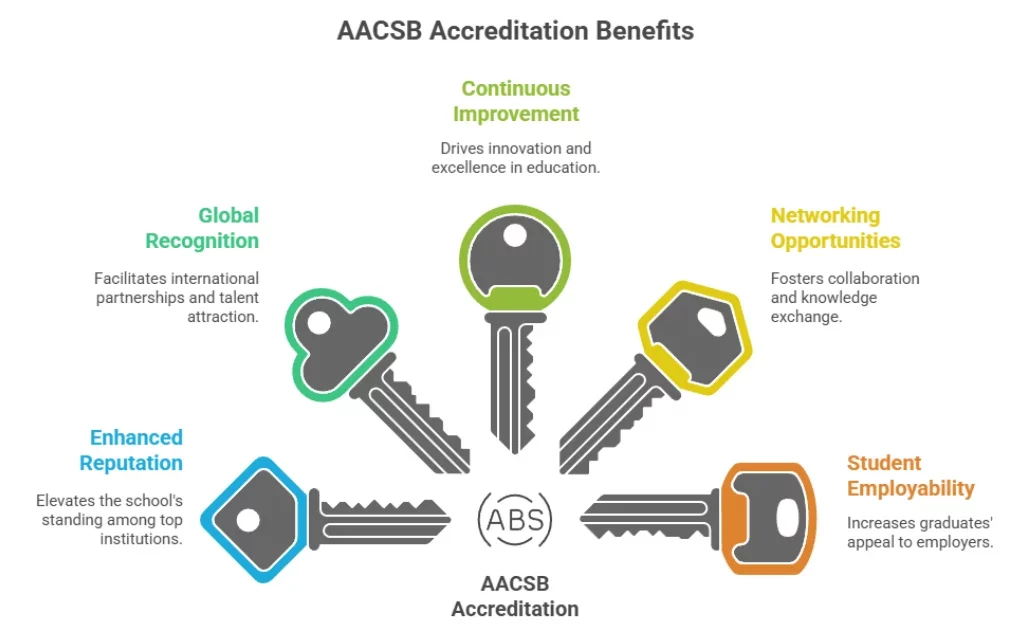What is AACSB Accreditation for Business Education?
By, Vaibhav Walzade

The journey toward excellence in business education starts with one critical milestone — AACSB Accreditation. Recognized worldwide as the gold standard for business school accreditation, AACSB (Association to Advance Collegiate Schools of Business) ensures that institutions meet the highest levels of quality, relevance, and continuous improvement. In this guide, we explore why AACSB Accreditation matters, what it requires, and how it transforms the landscape of management education globally.
What Is AACSB Accreditation?
AACSB Accreditation represents the gold standard in business school accreditation, Established in 1916, the AACSB sets the benchmark for excellence in business education. Earning this accreditation means a business school meets rigorous standards in areas like strategy, innovation, faculty quality, research, and engagement with stakeholders.
It’s a validation that the institution prepares students not just for the present business world, but for its evolving future.
Why AACSB Accreditation Matters
AACSB drives schools to examine and elevate every aspect of their academic ecosystem from curriculum design and faculty development to student outcomes and industry engagement.
This commitment to quality builds trust, fosters innovation, and ensures that graduates are truly ready for global business challenges.
Key Benefits of AACSB Accreditation
- – Enhanced Reputation: AACSB elevates the reputation of a business school, positioning it among the elite institutions in the field of management education.
- – Global Recognition: AACSB-accredited schools enjoy global recognition, facilitating partnerships with international institutions and attracting top talent from around the world.
- – Continuous Improvement: The accreditation process encourages a culture of continuous improvement, driving innovation and excellence in teaching, research, and outreach.
- – Networking Opportunities: AACSB membership opens doors to a vast network of educators, industry professionals, and thought leaders, fostering collaboration and knowledge exchange.
- – Student Employability: Graduates from AACSB-accredited programs are highly sought after by employers, given the rigorous academic standards and practical relevance embedded in the curriculum.

Beyond these core benefits
AACSB Accreditation signals to employers and other universities that a school’s degrees are highly respected. Students who complete AACSB-accredited programs often enjoy a competitive edge in the job market, with enhanced career prospects and access to better opportunities for graduate education. The recognition also reflects the collective efforts of dedicated leadership, support services, and highly-qualified faculty, all working together to deliver future-ready business education and cutting-edge research.
Ultimately, it empowers schools to drive employability, innovation, and real-world impact ensuring graduates are not only prepared for today’s challenges but positioned to lead in tomorrow’s business landscape
AACSB Accreditation Criteria
To earn AACSB accreditation, schools must demonstrate excellence across three pillars:
- Engagement – Active partnerships with businesses, alumni, and communities.
- Innovation – Modern, future-focused teaching methods and research initiatives.
- Impact – Tangible contributions to students, society, and the business ecosystem.
These criteria encompass various facets of institutional performance, including faculty qualifications, curriculum design, research output, and student success measures.
These dimensions ensure accredited institutions consistently deliver measurable, high-quality outcomes.
How the Accreditation Process For AACSB Works
The accreditation journey begins with a comprehensive self-assessment, followed by peer evaluation by AACSB experts.
Institutions must show evidence of effective leadership, clear strategic vision, faculty excellence, and measurable learning outcomes.
Throughout this process, schools receive personalized guidance, not just to meet standards but to exceed them through continuous improvement and data-driven enhancement.
Review Cycle For AACSB Accreditation
Maintaining the prestige of AACSB Accreditation is an ongoing commitment. Accredited institutions are required to undergo a comprehensive review every five years. This regular cycle ensures that schools remain aligned with AACBS’s evolving standards, fostering a culture of reflection, continuous improvement, and accountability at every stage. Institutions must demonstrate not only the maintenance of high standards but also measurable progress and innovation since their last review.
Conclusion
In conclusion, AACSB (Business school accreditation) serves as a beacon of excellence in business education, empowering institutions to deliver transformative learning experiences and prepare future leaders for success in a rapidly evolving global landscape. By embracing AACSB’s rigorous standards and commitment to continuous improvement, business schools can unlock new opportunities for growth, innovation, and impact.
